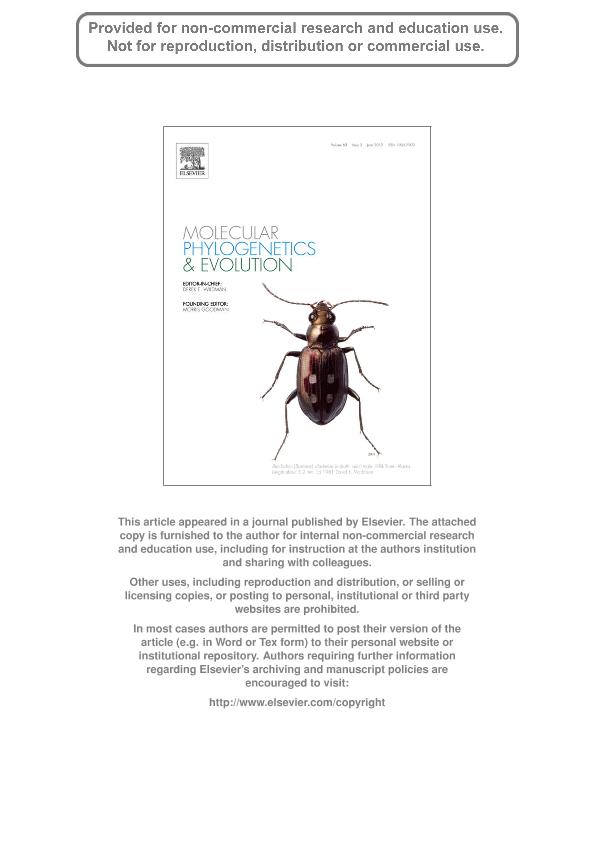Artículo
Evolutionary and biogeographic history of weasel-like carnivorans (Musteloidea)
Sato, Jun J.; Wolsan, Mieczyslaw; Prevosti, Francisco Juan ; D'Elía, Guillermo; Begg, Colleen; Begg, Keith; Hosoda, Tetsuji; Campbell, Kevin L.; Suzuki, Hitoshi
; D'Elía, Guillermo; Begg, Colleen; Begg, Keith; Hosoda, Tetsuji; Campbell, Kevin L.; Suzuki, Hitoshi
 ; D'Elía, Guillermo; Begg, Colleen; Begg, Keith; Hosoda, Tetsuji; Campbell, Kevin L.; Suzuki, Hitoshi
; D'Elía, Guillermo; Begg, Colleen; Begg, Keith; Hosoda, Tetsuji; Campbell, Kevin L.; Suzuki, Hitoshi
Fecha de publicación:
06/2012
Editorial:
Academic Press Inc Elsevier Science
Revista:
Molecular Phylogenetics and Evolution
ISSN:
1055-7903
Idioma:
Inglés
Tipo de recurso:
Artículo publicado
Clasificación temática:
Resumen
We analyzed a concatenated (8492. bp) nuclear-mitochondrial DNA data set from 44 musteloids (including the first genetic data for Lyncodon patagonicus) with parsimony, maximum likelihood, and Bayesian methods of phylogenetic and biogeographic inference and two Bayesian methods of chronological inference. Here we show that Musteloidea emerged approximately 32.4-30.9 million years ago (MYA) in Asia, shortly after the greenhouse-icehouse global climate shift at the Eocene-Oligocene transition. During their Oligocene radiation, which proceeded wholly or mostly in Asia, musteloids diversified into four primary divisions: the Mephitidae lineage separated first, succeeded by Ailuridae and the divergence of the Procyonidae and Mustelidae lineages. Mustelidae arose approximately 16.1 MYA within the Mid-Miocene Climatic Optimum, and extensively diversified in the Miocene, mostly in Asia. The early offshoots of this radiation largely evolved into badger and marten ecological niches (Taxidiinae, Melinae, Mellivorinae, Guloninae, and Helictidinae), whereas the later divergences have adapted to other niches including those of weasels, polecats, minks, and otters (Mustelinae, Ictonychinae, and Lutrinae). Notably, and contrary to traditional beliefs, the morphological adaptations of badgers, martens, weasels, polecats, and minks each evolved independently more than once within Mustelidae. Ictonychinae (which is most closely related to Lutrinae) arose approximately 9.5-8.9 MYA, most likely in Asia, where it diverged into the Old World Ictonychini (Vormela, Poecilictis, Ictonyx, and Poecilogale) and New World Lyncodontini (Lyncodon and Galictis) lineages. Ictonychini presumably entered Africa during the Messinian Salinity Crisis (at the Miocene-Pliocene transition), which interposed the origins of this clade (approximately 6.5-6.0 MYA) and its African Poecilictis- Ictonyx- Poecilogale subclade (approximately 4.8-4.5 MYA). Lyncodontini originated approximately 2.9-2.6 MYA at the Pliocene-Pleistocene transition in South America, slightly after the emergence of the Panamanian land bridge that provided for the Great American Biotic Interchange. As the genera Martes and Ictonyx (as currently circumscribed) are paraphyletic with respect to the genera Gulo and Poecilogale, respectively, we propose that Pekaniaand Poecilictis be treated as valid genera and that Martes pennanti and Ictonyx libyca, respectively, be assigned to these genera.
Palabras clave:
Biogeography
,
Carnivora
,
Divergence Times
,
Evolution
,
Mustelidae
,
Phylogeny
Archivos asociados
Licencia
Identificadores
Colecciones
Articulos(MACNBR)
Articulos de MUSEO ARG.DE CS.NAT "BERNARDINO RIVADAVIA"
Articulos de MUSEO ARG.DE CS.NAT "BERNARDINO RIVADAVIA"
Citación
Sato, Jun J.; Wolsan, Mieczyslaw; Prevosti, Francisco Juan; D'Elía, Guillermo; Begg, Colleen; et al.; Evolutionary and biogeographic history of weasel-like carnivorans (Musteloidea); Academic Press Inc Elsevier Science; Molecular Phylogenetics and Evolution; 63; 3; 6-2012; 745-757
Compartir
Altmétricas



